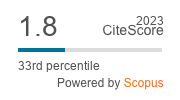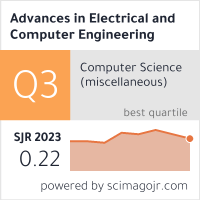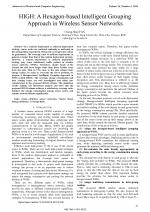| 1/2016 - 6 |
HIGH: A Hexagon-based Intelligent Grouping Approach in Wireless Sensor NetworksFAN, C.-S. |
| View the paper record and citations in |
| Click to see author's profile in |
| Download PDF |
Author keywords
wireless sensor networks, cluster head, energy efficiency, coverage ratio
References keywords
sensor(27), networks(20), deployment(11), systems(7), random(5), chen(5), information(4), computing(4), communications(4)
Blue keywords are present in both the references section and the paper title.
About this article
Date of Publication: 2016-02-28
Volume 16, Issue 1, Year 2016, On page(s): 41 - 46
ISSN: 1582-7445, e-ISSN: 1844-7600
Digital Object Identifier: 10.4316/AECE.2016.01006
Web of Science Accession Number: 000376995400006
SCOPUS ID: 84960075118
Abstract
In a random deployment or uniform deployment strategy, sensor nodes are scattered randomly or uniformly in the sensing field, respectively. Hence, the coverage ratio cannot be guaranteed. The coverage ratio of uniform deployment, in general, is larger than that of the random deployment strategy. However, a random deployment or uniform deployment strategy may cause unbalanced traffic pattern in wireless sensor networks (WSNs). Therefore, cluster heads (CHs) around the sink have larger loads than those farther away from the sink. That is, CHs close to the sink exhaust their energy earlier. In order to overcome the above problem, we propose a Hexagon-based Intelligent Grouping approacH in WSNs (called HIGH). The coverage, energy consumption and data routing issues are well investigated and taken into consideration in the proposed HIGH scheme. The simulation results validate our theoretical analysis and show that the proposed HIGH scheme achieves a satisfactory coverage ratio, balances the energy consumption among sensor nodes, and extends network lifetime significantly. |
| References | | | Cited By «-- Click to see who has cited this paper |
| [1] K. Shi, H. Chen and Yao Lin, "Probabilistic coverage based sensor scheduling for target tracking sensor networks," Information Sciences, vol. 292, no. 20, pp. 95-110, Jan. 2015. [CrossRef] [Web of Science Times Cited 34] [SCOPUS Times Cited 43] [2] W. Fang, S. Li, X. Liang and Z. Li, "Cluster-based data gathering in long-strip wireless sensor networks," Advances in Electrical and Computer Engineering, vol. 12, no. 1, pp. 3-8, Feb. 2012. [CrossRef] [Full Text] [Web of Science Times Cited 9] [SCOPUS Times Cited 11] [3] M. S. Familiar, J. F. Martinez, I. Corredor and C.G.-Rubio, "Building service-oriented smart infrastructures over wireless ad hoc sensor networks: A middleware perspective," Computer Networks, vol. 56, no. 4, pp.1303-1328, Mar. 2012. [CrossRef] [Web of Science Times Cited 20] [SCOPUS Times Cited 28] [4] E. I. Gokce, A. K. Shrivastava, J. J. Cho and Y. Ding, "Decision fusion from heterogeneous sensors in surveillance sensor systems," IEEE Trans. Automation Science and Engineering, vol. 8, no. 1, pp. 228-233, Jan. 2011. [CrossRef] [Web of Science Times Cited 11] [SCOPUS Times Cited 16] [5] Y. Wang, Q. Zhao, D. Zheng, X. Guan, "On optimisation of cluster-based sensor network tracking system," Int. J. of Ad Hoc and Ubiquitous Computing, vol. 14, no. 3, pp. 145-157, 2013. [CrossRef] [Web of Science Times Cited 2] [SCOPUS Times Cited 2] [6] R. Jiang, J. Luo and X. Wang, "HRKT: A hierarchical route key tree based group key management for wireless sensor networks," KSII Trans. on Internet and Information Systems, vol. 7, no. 8, pp. 2042-2060, Aug. 2013. [CrossRef] [Web of Science Times Cited 7] [SCOPUS Times Cited 8] [7] M. R. Senouci, A. Mellouk, A. Aissani, "Random deployment of wireless sensor networks: a survey and approach," Int. J. of Ad Hoc and Ubiquitous Computing, vol. 15, no. 1/2/3, pp. 133-146, 2014. [CrossRef] [Web of Science Times Cited 35] [SCOPUS Times Cited 44] [8] A. Liu, X. Jin, G. Cui and Z. Chen, "Deployment guidelines for achieving maximum lifetime and avoiding energy holes in sensor network," Information Sciences, vol. 230, no. 1, pp. 197-226, May 2013. [CrossRef] [Web of Science Times Cited 114] [SCOPUS Times Cited 137] [9] J. Jia, X. Wu, J. Chen, X. Wang, "An autonomous redeployment algorithm for line barrier coverage of mobile sensor networks," Int. J. of Ad Hoc and Ubiquitous Computing, vol. 16, no. 1, pp. 58-69, 2014. [CrossRef] [Web of Science Times Cited 9] [SCOPUS Times Cited 8] [10] Y. Taniguchi, T. Kitani and K. Leibnitz, "A uniform airdrop deployment method for large-scale wireless sensor networks," Int. J. of Sensor Networks, vol. 9, no. 3/4, pp. 182-191, May 2011. [CrossRef] [SCOPUS Times Cited 26] [11] T. E. Cheng, R. Bajcsy, "Congestion control and fairness for many-to-one routing in sensor networks," Proc. of the 2nd ACM Conf. on Embedded Networked Sensor Systems (SenSys), pp. 148-161, Nov. 2004. [CrossRef] [SCOPUS Times Cited 332] [12] M. Won, H. Ra, T. Park and S. H. Son, "Modeling random deployment in wireless sensor networks for infrastructure-less cyber physical systems," The 2nd IEEE Int. Conf. on Cyber-Physical Systems, Networks, and Applications, pp. 81-86, Aug. 2014. [CrossRef] [SCOPUS Times Cited 3] [13] K. B. Khajeh, M. A. J. Jamali and H. M. Manie, "ACDS: Adaptive topology construction for r-random sensor deployment in wireless sensor networks," 12th ACIS Int. Conf. on Software Engineering, Artificial Intelligence, Networking and Parallel/Distributed Computing, pp. 139-144, Jul. 2011. [CrossRef] [SCOPUS Times Cited 2] [14] N. Kulkarni, R. Prasad, H. Cornean and N. Gupta, "Performance evaluation of AODV, DSDV and DSR for quasi random deployment of sensor nodes in wireless sensor networks," Int. Conf. on Devices and Communications (ICDeCom), pp. 1-5, Feb. 2011. [CrossRef] [SCOPUS Times Cited 17] [15] P. Balister and S. Kumar, "Random vs. deterministic deployment of sensors in the presence of failures and placement errors," IEEE Int. Conf. on Computer Communications (INFOCOM), pp. 2896-2900, Apr. 2009. [CrossRef] [Web of Science Times Cited 32] [SCOPUS Times Cited 51] [16] Y. R. Tsai, "Sensing coverage for randomly distributed wireless sensor networks in shadowed environments," IEEE Trans. on Vehicular Technology, pp. 556-564, Jan. 2008. [CrossRef] [Web of Science Times Cited 81] [SCOPUS Times Cited 110] [17] M. R. Senouci, A. Mellouk, L. Oukhellou and A. Aissani, "Uncertainty-aware sensor network deployment," IEEE Global Telecommunications Conf. (GLOBECOM), pp. 1-5, Dec. 2011. [CrossRef] [SCOPUS Times Cited 26] [18] S. He, X. Gong, J. Zhang, J. Chen and Y. Sun, "Curve-based deployment for barrier coverage in wireless sensor networks," IEEE Trans. Wireless Communications, vol. 13, no. 2, pp. 724-735, Feb. 2014. [CrossRef] [Web of Science Times Cited 80] [SCOPUS Times Cited 83] [19] M. Eftekhari, L. Narayanan and J. Opatrny, "On multi-round sensor deployment for barrier coverage," IEEE 10th Int. Conf. on Mobile Ad-Hoc and Sensor Systems (MASS), pp. 310-318, Oct. 2013. [CrossRef] [Web of Science Times Cited 13] [SCOPUS Times Cited 16] [20] Y. Yoon and Y. H. Kim, "An efficient genetic algorithm for maximum coverage deployment in wireless sensor networks," IEEE Trans. on Cybernetics, vol. 43, no. 5, pp. 1473-1483, Oct. 2013. [CrossRef] [Web of Science Times Cited 245] [SCOPUS Times Cited 307] [21] G. Chen, S. K. Das and X. Wu, "Avoiding energy holes in wireless sensor networks with nonuniform node distribution," IEEE Trans. on Parallel and Distrib. Systems, vol.19, no.5, pp.710-720, May 2008. [CrossRef] [Web of Science Times Cited 317] [SCOPUS Times Cited 467] [22] W. K. Lai, C. S. Fan, and L. Y. Lin, "Arranging cluster sizes and transmission ranges for wireless sensor networks," Information Sciences, vol. 183, no. 1, pp. 117-131, Jan. 2012. [CrossRef] [Web of Science Times Cited 78] [SCOPUS Times Cited 113] [23] W. R. Heinzelman, A. Chandrakasan and H. Balakrishnan, "An application-specific protocol architecture for wireless microsensor networks," IEEE Trans. on Wireless Communications, vol. 1, no. 4, pp. 660-670, Oct. 2002. [CrossRef] [Web of Science Times Cited 5962] [SCOPUS Times Cited 9222] [24] H. Shen, "Finding the k most vital edges with respect to minimum spanning tree," Proc. IEEE National on Aerospace and Electronics Conf. (NAECON), vol. 1, pp. 255-262, July 1997. [CrossRef] Web of Science® Citations for all references: 7,049 TCR SCOPUS® Citations for all references: 11,072 TCR Web of Science® Average Citations per reference: 282 ACR SCOPUS® Average Citations per reference: 443 ACR TCR = Total Citations for References / ACR = Average Citations per Reference We introduced in 2010 - for the first time in scientific publishing, the term "References Weight", as a quantitative indication of the quality ... Read more Citations for references updated on 2024-07-24 01:19 in 162 seconds. Note1: Web of Science® is a registered trademark of Clarivate Analytics. Note2: SCOPUS® is a registered trademark of Elsevier B.V. Disclaimer: All queries to the respective databases were made by using the DOI record of every reference (where available). Due to technical problems beyond our control, the information is not always accurate. Please use the CrossRef link to visit the respective publisher site. |
Faculty of Electrical Engineering and Computer Science
Stefan cel Mare University of Suceava, Romania
All rights reserved: Advances in Electrical and Computer Engineering is a registered trademark of the Stefan cel Mare University of Suceava. No part of this publication may be reproduced, stored in a retrieval system, photocopied, recorded or archived, without the written permission from the Editor. When authors submit their papers for publication, they agree that the copyright for their article be transferred to the Faculty of Electrical Engineering and Computer Science, Stefan cel Mare University of Suceava, Romania, if and only if the articles are accepted for publication. The copyright covers the exclusive rights to reproduce and distribute the article, including reprints and translations.
Permission for other use: The copyright owner's consent does not extend to copying for general distribution, for promotion, for creating new works, or for resale. Specific written permission must be obtained from the Editor for such copying. Direct linking to files hosted on this website is strictly prohibited.
Disclaimer: Whilst every effort is made by the publishers and editorial board to see that no inaccurate or misleading data, opinions or statements appear in this journal, they wish to make it clear that all information and opinions formulated in the articles, as well as linguistic accuracy, are the sole responsibility of the author.





